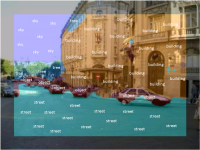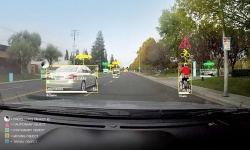Improving Scene Labeling with Hyperspectral Data
From iis-projects
Contents
Short Description
Hyperspectral imaging is different from normal RGB imaging in the sense that it does not capture the amount of light within three spectral bins (red, green, blue), but many more (e.g. 16 or 25) and not necessarily in the visual range of the spectrum. This allows the camera to capture more information than humans can process visually with their eyes and thus gives way to very interesting opportunities to outperform even the best-trained humans, in fact you can see it as a step towards spectroscopic analysis of materials.
Recently, a novel hyperspectral imaging sensor has been presented [video, pdf] and adopted in first industrial computer vision cameras [link]. These new cameras are only 31 grams w/o the lens as opposed to the old cameras which very very heavy and not mobile. Imaging sensor networks, UAVs, smartphones, driver assistance appliances, and other embedded computer vision systems require power-efficient, low-cost and high-speed implementations of synthetic vision systems capable of recognizing and classifying objects in a scene. Many popular algorithms in this area require the evaluations of multiple layers of filter banks. Almost all state-of-the-art synthetic vision systems are based on features extracted using multi-layer convolutional networks (ConvNets).
To be power efficient and achieve a high throughput at the same time, we would like to create a FPGA implementation of an entire scene labeling network. In order to keep the developed system flexible in terms of the convolutional neural network that is applied as well as the types of layer in the ConvNet, interaction between a flow controlling processor (e.g. an ARM core on a Xilinx Zynq) and the programmable logic is foreseen. If time permits or based on the preference of the student, some focus can also be given towards interfacing directly to a camera and a display or an ethernet adapter. As opposed to an ASIC project, such FPGA and hardware-software codesign work is much more applicable in industry and less constrained in terms of memory and interfaces. If desired by the student, also the use of high-level synthesis tools can be considered.
Status: Available
- Supervision: Lukas Cavigelli
- Date: tbd
Prerequisites
- Knowledge of Matlab
- Interest in VLSI design and computer vision
- VLSI 1
Character
- 20% Theory / Literature Research
- 80% VLSI Architecture, Implementation & Verification
Professor
Detailed Task Description
Goals
The goals of this project are
- for the student(s) to get to know the FPGA design flow from specification through architecture exploration to implementation, including the useof memory interfaces and other off-chip communication
- to learn how to gradually port software blocks to programmable logic and design an entire hetergeneous system using with software, FPGA fabric and hardwired interfaces.
Meetings & Presentations
The students and advisor(s) agree on weekly meetings to discuss all relevant decisions and decide on how to proceed. Of course, additional meetings can be organized to address urgent issues. At the end of the project, you have to present/defend your work during a 15 min. presentation and 5 min. of discussion as part of the IIS colloquium.\
Timeline
To give some idea on how the time can be split up, we provide some possible partitioning:
- Literature survey, building a basic understanding of the problem at hand, catch up on related work
- Development of a working software-based implementation running on the Zynq's ARM core
- Piece-by-piece off-loading of relevant tasks to the programmable logic
- Implementation of data interfaces (software or hardware)
- Report and presentation
Literature
- Hardware Acceleration of Convolutional Networks:
- C. Farabet, B. Martini, B. Corda, P. Akselrod, E. Culurciello and Y. LeCun, "NeuFlow: A Runtime Reconfigurable Dataflow Processor for Vision", Proc. IEEE ECV'11@CVPR'11 [1]
- V. Gokhale, J. Jin, A. Dundar, B. Martini and E. Culurciello, "A 240 G-ops/s Mobile Coprocessor for Deep Neural Networks", Proc. IEEE CVPRW'14 [2]
- [3]
- two not-yet-published papers by our group on acceleration of ConvNets

